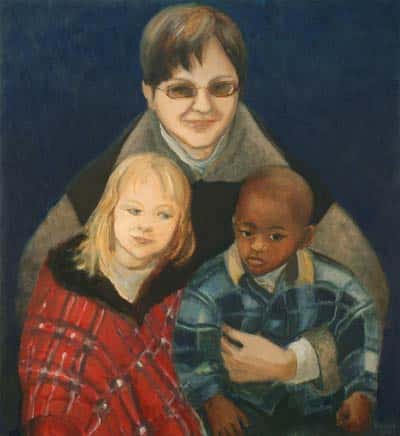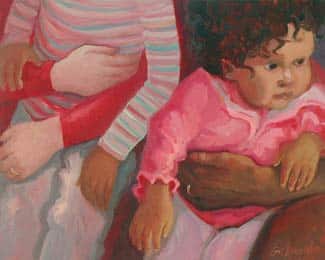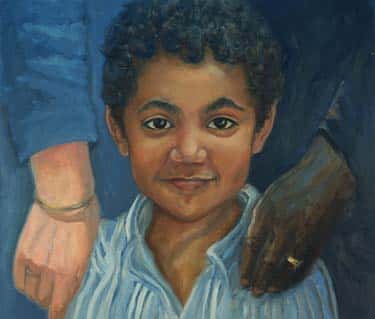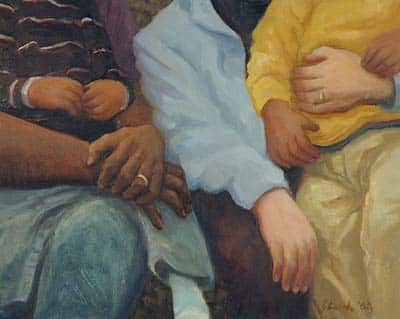by Eleanor J. Bader
It is the third week of classes at P.S. 130, The Parkside School in Brooklyn, New York. A group of fourth graders sits on the floor, watching five others — a mix of nine and 10-year-olds from other classes in the school — take seats in front of the room.

Emma Gonzalez, a group facilitator from The Morningside Center for Teaching Social Responsibility, gets the ball rolling by introducing the theme, respect for difference. “We are all different in many ways but we need to live together respectfully,” she begins.
A quick survey of where the students or their parents are from hammers the point: Albania, Bangladesh, the Dominican Republic, Jamaica, Japan, Korea, Mexico, Poland, Puerto Rico, Trinidad. “This diversity makes the world very rich,” Gonzalez continues. “Imagine a world where we were all the same. That would be boring.”
Heads nod as Gonzalez tells the assembled students that the children in front of them are going to describe how they’ve been hurt by racial or religious prejudice.
Ibrahim begins. “I was in Burger King and this lady came up to my sister and asked where we were from. She told her Egypt and the lady said, ‘You should tell your parents to convert to Catholic.’ That made me mad.”
Another boy describes being made fun of for speaking Arabic. Then Ivette takes a deep breath and shakily tells the group about an incident in the lunchroom. “This boy came up to me and said, ‘People from Jamaica are stupid. I hate your culture and I hate you.’”
Gonzalez jumps in. “He didn’t even know you, did he?”
The students are riveted by what they’ve heard and when Gonzalez asks if any of them have had similar encounters, almost every hand goes up. “It’s sometimes hard to talk about things that make us sad or angry,” Gonzalez continues. “But see, you are not alone. That’s why we all need to tell our stories.”
And they do, one after another describing insults that have been lobbed in their direction.
| Children need to learn how to have empathy for others. |
“Once the children learn that the people around them won’t laugh or make fun of them, it’s healing for them to tell their stories,” Gonzalez says. “They discover that they don’t have to hide or be silent. They can stand up for themselves and be assertive. They also learn to be good listeners as the storytelling catches fire. From time to time someone will cry, but it ends the isolation to hear that other people have been called names, making it easier to talk about ways to stop these comments and behaviors.”
The Morningside Center was founded in 1982 — it was originally called Educators for Social Responsibility, Metro Chapter, but was renamed to honor the Morningside Heights neighborhood in which it is based — by teachers concerned about the dangers of nuclear war. It has since evolved into a nationally recognized champion of social and emotional learning, known as SEL, bringing programs to approximately 80 New York City public schools a year.
Inadequate Skills Undermine Democracy

Daniel Goleman, a psychologist and author of the bestselling book, Emotional Intelligence, is one of the founders of a now-international social and emotional learning movement that is pushing for the inclusion of SEL in pre-K to high school classrooms. He and other SEL proponents believe that in addition to academic mastery, children need to learn how to handle distress and negative emotions, be self-aware, and have empathy for others, whether the others are of a different race, ethnic group, gender, or sexual preference. These teachable skills, they argue, are imperative since scholastic achievement alone is not enough to ensure personal or workplace success once the students come of age. Worse, Goleman warns that democratic governance is undermined when these skills are not adequately developed.
“Careful research evaluations are showing that SEL not only improves children’s social and emotional abilities, Goleman writes, but also lowers risks like violence, substance abuse and unwanted teen pregnancies, while making kids better behaved and more positive about learning.”
While teachers are not therapists, SEL advocates encourage them to intervene when students bring emotional baggage or racial or ethnic stereotypes into the classroom. The rationale for doing so is simple. Recent studies conducted by Columbia University researchers and the Collaborative for Academic, Social and Emotional Learning, or CASEL, a network of SEL proponents working in all parts of the U.S., found that students who learn to resolve conflicts and deal with their feelings constructively — whether anxiety, frustration, rage, or sadness — make more academic progress than those who don’t. What’s more, every teacher knows that discipline problems and aggression hamper learning and that students who feel safe and relaxed absorb far more than those who are tense, uncomfortable or worried about being attacked.
Central to this success, says CASEL, is the relationship between teacher and student. When students believe their teachers are genuinely concerned about their well being, learning flourishes. And, since children tend to mimic what they see, seeing people who care about what others think and feel reinforces positive behavior.
Teachable Moments On Oppression For Thousands of Kids
The Morningside Center’s programs —Resolving Conflict Creatively; the Four R’s; and Teachable Moment, among them — are geared to students at every level, pre-school to 12th grade. “Every curriculum we develop has diversity, bias awareness and countering bias as components,” says Tom Roderick, Executive Director of The Morningside Center. “We always cover the four I’s: Institutional or systemic oppression; interpersonal relations; ideological bias; and internalized oppression.”

Each program offered by Morningside — most are yearlong rather than short-term — tries to tap into personal experiences and all include exercises to help students become more assertive. Questions are posed: How do you stand up to discrimination? How can you become an ally for someone who is being bullied or abused?
“We try to get across the idea that it’s best to think flexibly,” Roderick continues. “We’re promoting behavior that treats people with respect and that strives for win-win solutions. But we’re also saying, ‘Stand up for yourself. Don’t be a doormat.’ We define intelligence as finding the best response to any given situation.”
The Four R’s — Reading, Writing, Respect and Resolution — Program does this by weaving conflict resolution — how we can disagree without belittling or insulting each other–into language arts lessons. It uses children’s literature, as a springboard into pre-K, elementary, and middle school classrooms. Texts include The Pain and the Great One by Judy Blume and Irene Trivas.
Similarly, the 24-year-old Resolving Conflict Creatively curriculum is predicated on the belief that “listening is a skill that can be learned.” According to the Morningside Center’s website, “We assume not only that good listening is essential in dealing with conflict, but that we can all become better listeners.”
Still another Morningside program, called Teachable Moment, provides free and constantly updated resources for educators about newsworthy events. Recent postings focus on the arrest of Harvard professor Henry Louis Gates, U.S. military involvement in Afghanistan, President Obama’s health proposals, and the treatment of people suspected of having terrorist ties.
| Listening is a skill that can be learned. |
Typically, questions are posed. “Why does Judge Sotomayor point out that wise men on the Supreme Court upheld both sex and race discrimination in our society and that until 1972 did not uphold the claim of a woman in a gender discrimination case? Why does she also point out that nine white men voted to end school segregation in 1954?” asks one lesson.
Although Teachable Moment materials are used in classrooms nationwide, most of The Morningside Center’s work takes place within the five boroughs of New York City. Last year, however, a multi-media program called Nothing Like My Home brought information about Iraqi refugees to 10 schools in the northeast and midwest.
“No Child Left Behind” Harms Programs
But despite The Morningside Center’s 27-year track record — educators and evaluators consistently dub it the gold standard of social and emotional learning programs — the group’s work has not been without obstacles. Since the advent of the federal government’s No Child Left Behind Act in 2002, Morningside, like other SEL programs, has had to adapt to changing federal certification requirements.

“Schools have had to spend considerable time and energy on testing and even teachers who oppose the testing regimen have to prepare kids for the exams,” Roderick admits. “This has pushed social and emotional learning, physical education and the arts to the fringes, and has narrowed the curriculum. Teachers are pretty hamstrung by “No Child Left Behind,” but there has been a push back.”
Clearly, educators know what works. Melinda Fine, of Fine Consulting, an independent New York City firm offering assistance to educational nonprofits and philanthropies, calls The Morningside Center a leader in the SEL community. She is particularly impressed by the organization’s ability to weave social and emotional learning into everyday course work. “SEL works best when it is integrated into what the class needs to be doing academically and is not an add-on to the curriculum,” she says. “It works best when it is embedded within a school or classroom climate; is sustained rather than episodic; and when it has a parent component so that there’s a way for adult caregivers to weigh in.” Morningside Center’s ongoing support for classroom teachers is also paramount, she says, since having a place to pose questions about what and when to take particular steps is essential for SEL effectiveness.
In the end, however, it is what happens in the classroom that matters most to Morningside staff.
“Last year there was an incident where a teacher told her first graders to hold their partner’s hand while walking to the cafeteria,” Gonzalez recalls. “One white child said, ‘No. I don’t want to hold her hand because it is the color of dirt and I’m going to eat so don’t want to get dirty.’” Needless to say, the child’s partner was stunned by the outburst. Still, says Gonzalez, after discussing what had happened and its impact, the two children reached détente, if not friendship.
“Our work is a process,” Gonzalez concludes, “that gives us a resonant way to teach about discrimination, racism, and diversity.” Indeed, questions about disabilities, what it means to be male or female, and how cultural practices vary from one community to another, all find a place in Morningside Center’s constantly evolving programs and curricula.
“When we started developing in the 1980’s,” Tom Roderick adds, “we came upon a quote from Mahatma Gandhi: ‘If we are to teach real peace in this world, and if we are to carry on a real war against war, we shall have to begin with the children.’ That was it. Begin with the children. Morningside Center’s work developed from there.”
** All student names have been changed.
See a video on Social and Emotional Learning with Morningside’s program at Brooklyn’s P.S. 24.
Eleanor J. Bader is a freelance writer, teacher, and activist. She writes for The Brooklyn Rail, The L Magazine, RHRealitycheck.org, and other progressive and feminist publications.
Also see Faith Ringgold, The Art Perspective in this edition of On The Issues Magazine.
